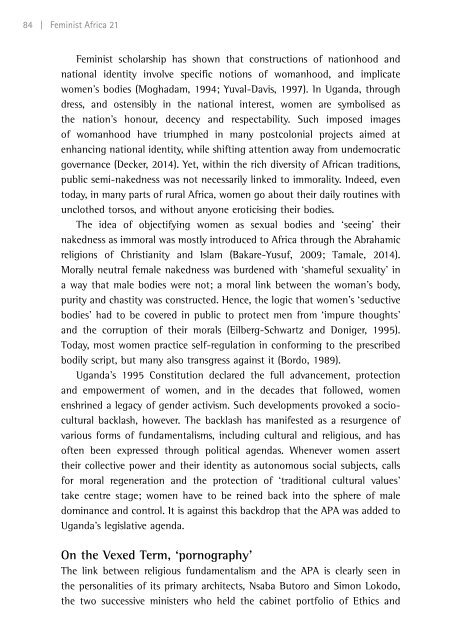The politics of fashion and beauty in Africa
fa21_proof_3
fa21_proof_3
You also want an ePaper? Increase the reach of your titles
YUMPU automatically turns print PDFs into web optimized ePapers that Google loves.
84 | Fem<strong>in</strong>ist <strong>Africa</strong> 21<br />
Fem<strong>in</strong>ist scholarship has shown that constructions <strong>of</strong> nationhood <strong>and</strong><br />
national identity <strong>in</strong>volve specific notions <strong>of</strong> womanhood, <strong>and</strong> implicate<br />
women’s bodies (Moghadam, 1994; Yuval-Davis, 1997). In Ug<strong>and</strong>a, through<br />
dress, <strong>and</strong> ostensibly <strong>in</strong> the national <strong>in</strong>terest, women are symbolised as<br />
the nation’s honour, decency <strong>and</strong> respectability. Such imposed images<br />
<strong>of</strong> womanhood have triumphed <strong>in</strong> many postcolonial projects aimed at<br />
enhanc<strong>in</strong>g national identity, while shift<strong>in</strong>g attention away from undemocratic<br />
governance (Decker, 2014). Yet, with<strong>in</strong> the rich diversity <strong>of</strong> <strong>Africa</strong>n traditions,<br />
public semi-nakedness was not necessarily l<strong>in</strong>ked to immorality. Indeed, even<br />
today, <strong>in</strong> many parts <strong>of</strong> rural <strong>Africa</strong>, women go about their daily rout<strong>in</strong>es with<br />
unclothed torsos, <strong>and</strong> without anyone eroticis<strong>in</strong>g their bodies.<br />
<strong>The</strong> idea <strong>of</strong> objectify<strong>in</strong>g women as sexual bodies <strong>and</strong> ‘see<strong>in</strong>g’ their<br />
nakedness as immoral was mostly <strong>in</strong>troduced to <strong>Africa</strong> through the Abrahamic<br />
religions <strong>of</strong> Christianity <strong>and</strong> Islam (Bakare-Yusuf, 2009; Tamale, 2014).<br />
Morally neutral female nakedness was burdened with ‘shameful sexuality’ <strong>in</strong><br />
a way that male bodies were not; a moral l<strong>in</strong>k between the woman’s body,<br />
purity <strong>and</strong> chastity was constructed. Hence, the logic that women’s ‘seductive<br />
bodies’ had to be covered <strong>in</strong> public to protect men from ‘impure thoughts’<br />
<strong>and</strong> the corruption <strong>of</strong> their morals (Eilberg-Schwartz <strong>and</strong> Doniger, 1995).<br />
Today, most women practice self-regulation <strong>in</strong> conform<strong>in</strong>g to the prescribed<br />
bodily script, but many also transgress aga<strong>in</strong>st it (Bordo, 1989).<br />
Ug<strong>and</strong>a’s 1995 Constitution declared the full advancement, protection<br />
<strong>and</strong> empowerment <strong>of</strong> women, <strong>and</strong> <strong>in</strong> the decades that followed, women<br />
enshr<strong>in</strong>ed a legacy <strong>of</strong> gender activism. Such developments provoked a sociocultural<br />
backlash, however. <strong>The</strong> backlash has manifested as a resurgence <strong>of</strong><br />
various forms <strong>of</strong> fundamentalisms, <strong>in</strong>clud<strong>in</strong>g cultural <strong>and</strong> religious, <strong>and</strong> has<br />
<strong>of</strong>ten been expressed through political agendas. Whenever women assert<br />
their collective power <strong>and</strong> their identity as autonomous social subjects, calls<br />
for moral regeneration <strong>and</strong> the protection <strong>of</strong> ‘traditional cultural values’<br />
take centre stage; women have to be re<strong>in</strong>ed back <strong>in</strong>to the sphere <strong>of</strong> male<br />
dom<strong>in</strong>ance <strong>and</strong> control. It is aga<strong>in</strong>st this backdrop that the APA was added to<br />
Ug<strong>and</strong>a’s legislative agenda.<br />
On the Vexed Term, ‘pornography’<br />
<strong>The</strong> l<strong>in</strong>k between religious fundamentalism <strong>and</strong> the APA is clearly seen <strong>in</strong><br />
the personalities <strong>of</strong> its primary architects, Nsaba Butoro <strong>and</strong> Simon Lokodo,<br />
the two successive m<strong>in</strong>isters who held the cab<strong>in</strong>et portfolio <strong>of</strong> Ethics <strong>and</strong>



